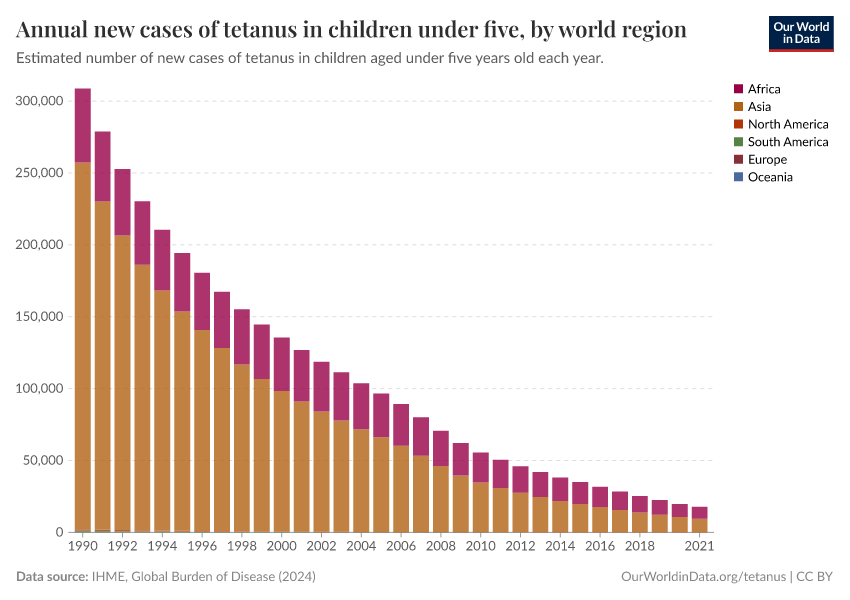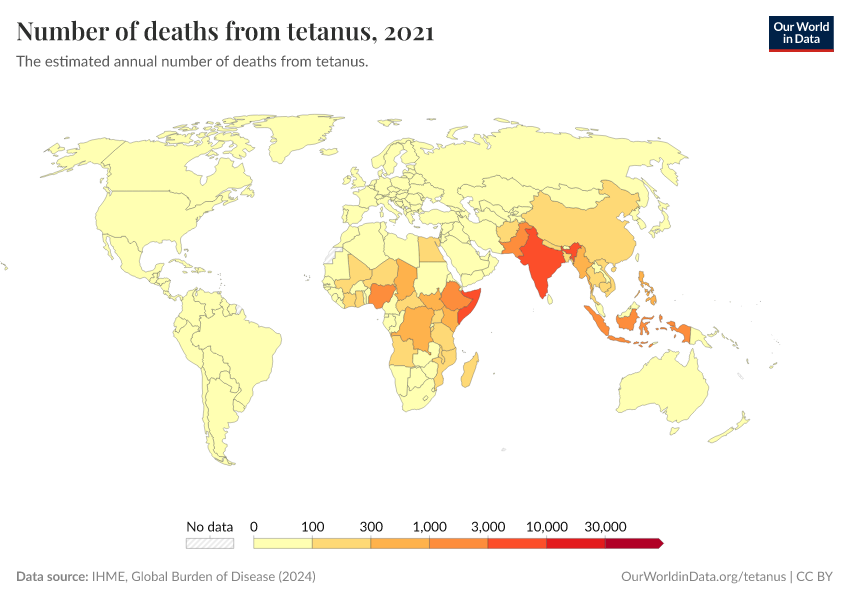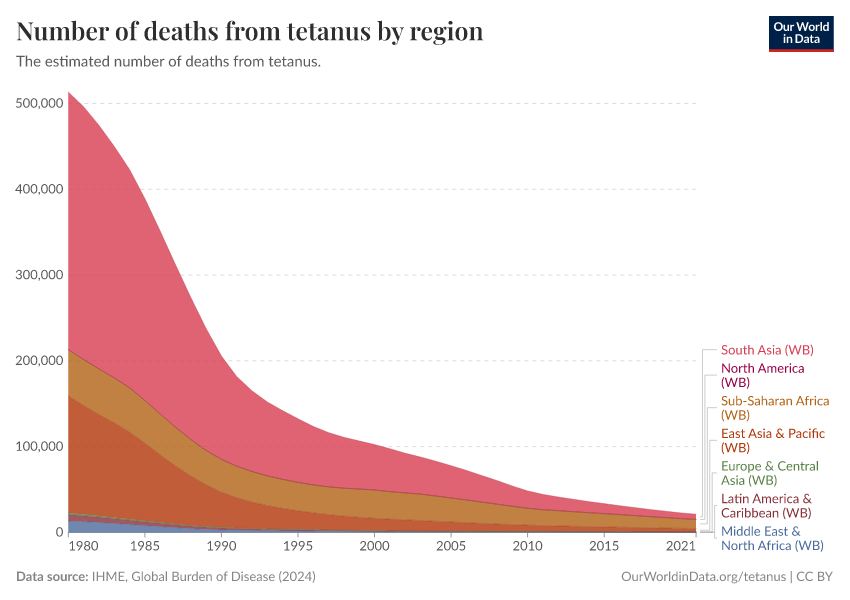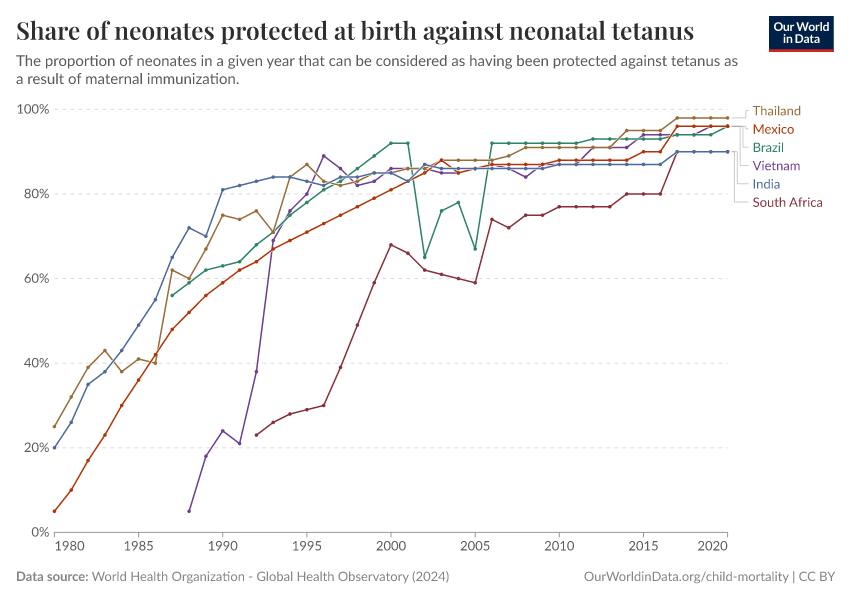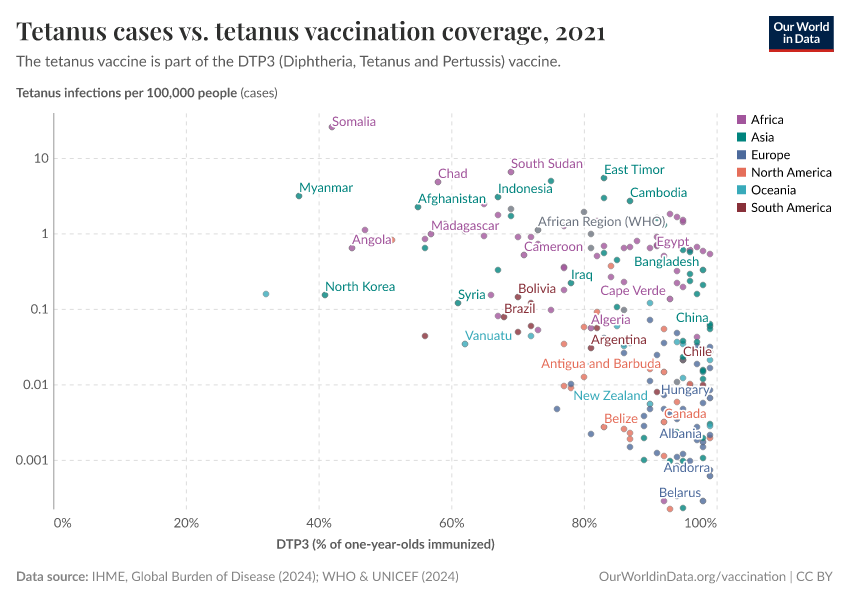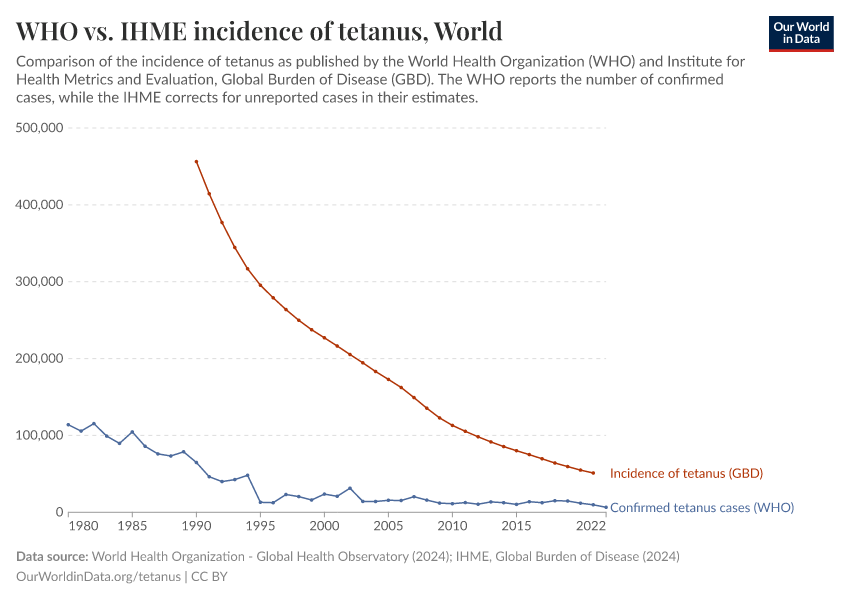Tetanus
Tetanus is a bacterial infection that leads to painful muscle contractions and possibly death.
This page was first published in March 2019 and we updated the text in January 2024.
Tetanus is a disease caused by the bacteria Clostridium tetani. It can be caught from dirt that enters wounds, which especially affects mothers giving birth and newborns.
The bacteria release a toxin that prevents the normal functioning of nerves, and can eventually lead to paralysis, difficulty breathing, and death.
Over time, the impact of tetanus has been reduced greatly with the use of vaccines, especially the DTP vaccine, which protects mothers and newborns against the disease.
However, the disease still causes around 50,000 deaths worldwide annually, and especially affects regions where sanitation is lacking and vaccination rates are low.
This topic page presents a global overview of tetanus and MNT, presenting data on cases and deaths, and explaining transmission, prevention, and the efforts to eliminate tetanus.
See all interactive charts on tetanus ↓
What causes tetanus?
Tetanus is caused by the toxin of a bacterium, Clostridium tetani, found in human and animal feces, soil, and street dust. The bacteria enter the body through wounds.
By a week or two after infection, the bacteria releases a toxin that enters nerves responsible for movement and prevents them from functioning properly.1
This causes symptoms such as muscle stiffness, “lockjaw” (paralysis of the jaw), spasms, back pain, and difficulty breathing.
It’s estimated that, in Africa, around 45% of adults who develop tetanus then die from the disease.2
Tetanus can be prevented through vaccination, with the DTP vaccine, which protects against diphtheria, tetanus, and pertussis together.
Tetanus is a disease that is infectious but not contagious or communicable.
One can become infected with it, e.g. through dirt that enters wounds, but cannot transmit the disease to other people directly (it is not communicable).
Even if the number of tetanus cases were reduced to zero at one point in the future tetanus would not be eradicated. As the disease-causing bacteria can be found in soil, unvaccinated people can become reinfected at any time.
Continued vaccination efforts are therefore necessary to control tetanus.
The global burden of tetanus
Since 1990, the number of deaths from tetanus has fallen greatly
Over the past three decades, we have seen a significant fall in the estimated number of deaths from tetanus globally. You can see this in the chart. In the 1990s, it’s estimated that hundreds of thousands of people died from tetanus each year. In contrast, in the 2010s, that figure had declined to around 50,000 deaths annually.

Most deaths from tetanus occur in children under 5
The chart also shows that the majority of tetanus deaths in the past and today occur in children under the age of 5.
Notably, if you switch the country in the chart to any high-income country or region, such as Central Europe, you will see that tetanus in children is very uncommon in those places.
This is in large part due to a highly effective childhood vaccine that we have available for this disease.

Where do most cases of tetanus occur?
New tetanus cases by region
Today the majority of new cases of tetanus occur in South Asia and Sub-Saharan Africa.
As the chart shows, these two regions account for the majority of all tetanus cases globally. Similarly, the majority of all deaths from tetanus, occur in South Asia and Sub-Saharan Africa.
However, even though South Asia still sees more cases of tetanus than any other region, in just three decades the number of new infections has fallen massively, from close to 400,000 infections in 1990 to around 30,000 in 2019.

New tetanus cases by country
The map here shows the estimated number of new tetanus infections by country.
By clicking the play button you can see how this changed over time.
In the 1990s, many countries in Africa and Asia had tetanus infection rates greater than 5 per 100,000 people per year.
Several countries, such as India, Pakistan, Chad, and Somalia, had tetanus infection rates higher than 20 per 100,000 people.
But by 2019, infection rates had declined in many countries, and only a few countries worldwide had infection rates of tetanus greater than 5 per 100,000 people per year.

In which countries do people still die from tetanus?
In the chart, you see death rates from tetanus by country.
This is given as the rate of tetanus deaths per 100,000 people in the population, and is age-standardized to allow for comparisons between countries and over time.
You can view the total number of deaths by country here.

How do we prevent tetanus?
Vaccination protects against tetanus
Today we have an effective vaccine against tetanus. The vaccine is called “DTP”, which protects against not only tetanus but also diphtheria and pertussis.
Decline of tetanus with vaccination coverage increase
Before 1980, the number of tetanus cases had already declined in high-income countries with good hygiene and immunization programs.
Since then, the global number of cases of tetanus and global coverage of vaccination against tetanus were monitored and allowed a comparison.
As vaccination for tetanus has increased, the number of tetanus cases declined, as the charts show below.


DTP coverage today
WHO recommends DTP vaccination of babies and subsequent follow-ups in childhood, teenage, and adult years. In countries with good vaccination programs tetanus has been largely eliminated.3
In the chart, you can see how global tetanus vaccine coverage varies worldwide. Vaccination rates are much higher than in the past, as you can see if you click the play button. But many countries, especially in Africa and South America, still lag in vaccination rates.

Tetanus treatment
If a person gets infected with tetanus-causing bacteria, treatment involves antibiotics, antitoxin against the bacterial toxin, and spasm-controlling drugs.
In addition, tetanus survivors still need to be vaccinated as the infection does not result in immunity to the disease.
Maternal and Neonatal Tetanus
Maternal and neonatal tetanus is common where access to immunization and clean delivery is insufficient
Tetanus that affects newborns and their mothers is referred to as Maternal and Neonatal Tetanus (MNT).4
Maternal and neonatal tetanus cases are linked to inequality in access to healthcare services.
Because tetanus bacteria spores are present in the environment, clean birth delivery services are essential for the protection of mothers and newborns during delivery.
If the environment during birth is not hygienic, mothers can contract tetanus through tears and wounds during delivery, and newborns can be infected by tetanus through the umbilical stump.
Vaccination of mothers and newborns protects from MNT and most cases of MNT occur in places where vaccine coverage is insufficient.
In the map, you can see how the distribution of neonatal tetanus cases changed across the world since 1980.

Elimination of maternal and neonatal tetanus
In 1988 the WHO declared the goal to eliminate neonatal tetanus by 1995.
The elimination target was set to 1 case of MNT per 1000 live births. Due to slow progress, this goal was pushed back to 2000, then 2005, and eventually no specific goal was set.
Instead, the organizations Kiwanis and UNICEF partnered in 2010 to form the ELIMINATE project which aims to eliminate tetanus in the remaining 39 countries.5
In 2020, 47 countries have eliminated MNT and 12 countries remain. This progress is shown on the map here.

Key Charts on Tetanus
See all charts on this topicEndnotes
Specifically, it prevents the release of the signaling substance GABA from nerve cells.
Woldeamanuel, Y. W., Andemeskel, A. T., Kyei, K., Woldeamanuel, M. W., & Woldeamanuel, W. (2016). Case fatality of adult tetanus in Africa: Systematic review and meta-analysis. Journal of the Neurological Sciences, 368, 292–299. https://doi.org/10.1016/j.jns.2016.07.025
Centers for Disease Control and Prevention. (2018). Tetanus. Available at: https://www.cdc.gov/vaccines/pubs/pinkbook/tetanus.html.
World Health Organization (2018) Maternal and Neonatal Tetanus Elimination (MNTE). Retrieved on 18 December 2018, from here.
World Health Organization. (2018). Maternal and Neonatal Tetanus Elimination (MNTE). Retrieved 27 November 2018, from http://www.who.int/immunization/diseases/MNTE_initiative/en//.
Cite this work
Our articles and data visualizations rely on work from many different people and organizations. When citing this topic page, please also cite the underlying data sources. This topic page can be cited as:
Hannah Behrens, Sophie Ochmann, Bernadeta Dadonaite, and Max Roser (2019) - “Tetanus” Published online at OurWorldinData.org. Retrieved from: 'https://ourworldindata.org/tetanus' [Online Resource]BibTeX citation
@article{owid-tetanus,
author = {Hannah Behrens and Sophie Ochmann and Bernadeta Dadonaite and Max Roser},
title = {Tetanus},
journal = {Our World in Data},
year = {2019},
note = {https://ourworldindata.org/tetanus}
}Reuse this work freely
All visualizations, data, and code produced by Our World in Data are completely open access under the Creative Commons BY license. You have the permission to use, distribute, and reproduce these in any medium, provided the source and authors are credited.
The data produced by third parties and made available by Our World in Data is subject to the license terms from the original third-party authors. We will always indicate the original source of the data in our documentation, so you should always check the license of any such third-party data before use and redistribution.
All of our charts can be embedded in any site.
